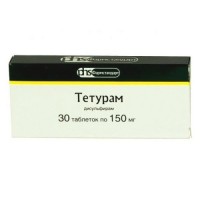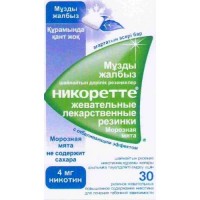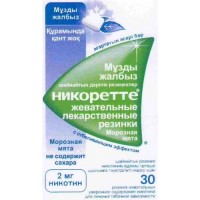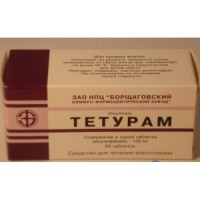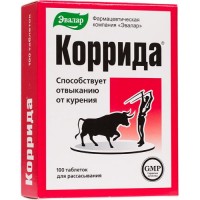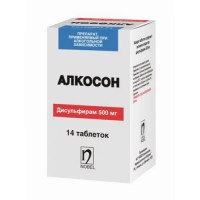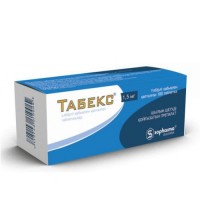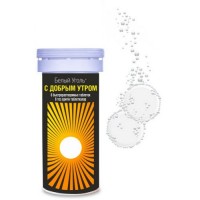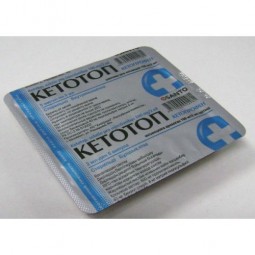Nicorette 1 mg / dose 13.2 ml spray metered 1's
- $38.30
The instruction for medical use of Nikorette® medicine the Trade name of Nikorette® the International unlicensed name Is not present the Dosage form Spray the dosed Structure 1 ml of drug contains active agent - nicotine of 13.6 mg, excipients: propylene glycol, ethanol, trometamol, half-oxameasures, glitserol, Natrii hydrocarbonas, left menthol, fragrance mint QL24245, Cooler 2 SN046680 fragrance, a sucralose, to potassium atsesulfa, acid chlorohydrogen to pH 9.0, the water purified to 1 ml. The description Solution from transparent to poorly opalescent, from colourless till light yellow color Pharmacotherapeutic group Nervous system. Drugs for treatment of diseases of nervous system others. Drugs for treatment of addictive disorders. The drugs used in nicotine addiction. Nicotine the ATX N07BA01 Code the Pharmacological Pharmacokinetics Pharmacokinetics properties of nicotine it is comprehensively studied, it was established that the way of delivery of substance to an organism has significant effect on speed and extent of absorption. The spray pharmacokinetics for a mucous membrane of an oral cavity is studied in four researches including 141 subjects. Absorption the Dosage form spray for a mucous membrane of an oral cavity assumes that the dose of nicotine arrives immediately and, as a result, its absorption from an oral cavity fast. The maximum concentration equal of 5.3 ng/ml, is reached within 13 min. after introduction of 2 mg of nicotine. 10 min. later after use of spray in doses of 1 and 2 mg the area under a curve concentration time (AUC) exceeded the similar values received in the researches of chewing gum and tablets containing 4 mg of nicotine (0.48 and 0.64 ч×нг/мл, in comparison with 0.33 and 0.33 ч×нг/мл). AUC values ∞ demonstrate that the bioavailability of nicotine when putting spray on a mucous membrane of an oral cavity is similar to bioavailability at use of tablets and are slightly higher, than at use of nicotinic chewing gum. AUC ∞ for spray a dosage of 2 mg equaled 14.0 ч×нг/мл in comparison with 23.0 ч×нг/мл for chewing gum a dosage of 4 mg and 26.7 ч×нг/мл for tablets a dosage of 4 mg. The average equilibrium concentration of nicotine in blood plasma reached after introduction of the maximum dose (i.e. 2 injections of spray in a dose of 1 mg each 30 min.), approximately equaled 28.8 ng/ml in comparison with 23.3 ng/ml at use of chewing gum a dosage of 4 mg (1 small pillow each hour) and 25.5 ng/ml for nicotine tablets a dosage of 4 mg (1 tablet each hour). In view of fast absorption and similar high relative bioavailability, the most part of the nicotine released from spray is soaked up, obviously, through a mucous membrane of cheeks. Distribution makes distribution Volume after intravenous administration of nicotine from 2–3 l/kg. Linking of nicotine with proteins of blood plasma makes less than 5%. For this reason of change of binding of nicotine at use of the accompanying drugs or changes of content of proteins of blood plasma in a number of diseases, presumably, should not have significant effect on nicotine pharmacokinetics. Biotransformation Metabolism and removal of nicotine do not depend on a dosage form and therefore results of a research of nicotine at intravenous administration are suitable for their description. The main body, eliminiruyushchy nicotine, the liver is. Nevertheless, nicotine is also metabolized in kidneys and lungs. More than 20 metabolites of nicotine are known, at the same time all of them, apparently, are less active in comparison with initial connection. Plasma elimination half-life of the main metabolite of nicotine – a kotinin – is equal to 15-20 h, and its concentration exceeds that for nicotine by 10 times. Removal the Average plasma clearance of nicotine is equal to 70 l/hour, elimination half-life makes 2–3 h. The main metabolites of nicotine found in urine are kotinin (12% of the entered dose) and trance-3-hydroksikotinin (37% of the entered dose). About 10% of nicotine are removed with urine in not changed look. At a high speed of filtration and pH of urine the 5th amount of the nicotine removed with urine in an invariable look is lower, can reach 30%. Linearity/nonlinearity By 1, 2, 3 and 4 pressing of spray with a dosage 1 mg / a dose revealed only an insignificant deviation from linearity of AUC ∞ and Cmax. Special groups of patients the Renal failure Progressing of a renal failure is followed by decrease in the general clearance of nicotine. The clearance of nicotine at patients with a heavy renal failure is reduced on average by 50%. At patients on a hemodialysis the increase in concentration of nicotine was noted. An abnormal liver function the nicotine Pharmacokinetics at patients with a slight abnormal liver function (5 points on a scale of Chayld-Pyyu) did not change, but in the presence of an abnormal liver function of average degree (7 points on a scale of Chayld-Pyyu) decreased by 40–50%. Data on nicotine pharmacokinetics in an abnormal liver function more than 7 points on a scale of Chayld-Pyyu are absent. Elderly patients At healthy patients of advanced age the small decrease in the general clearance of nicotine which is not demanding change of a dose of drug is noted. The pharmacodynamics Nikotin is agonist of nicotinic receptors in peripheral and to the central nervous system (CNS), has the significant impact on central nervous system and a cardiovascular system. The sharp refusal of smoking causes development of a characteristic withdrawal, including thirst for smoking. Clinical trials showed that drugs for replacement nicotinic therapy allow smokers to refrain from smoking, facilitating symptoms of cancellation. The research of a single dose at 200 healthy smokers showed that when using two doses of spray on 1 mg the desire to light decreases, since first minute after use of spray and in much bigger degree, than at use of the tablets for resorption containing nicotine. In comparison with chewing nicotinic gum or tablets for resorption, absorption of nicotine from spray for a mucous membrane of an oral cavity faster (see the section Pharmacokinetics) and, based on the accumulated experience of use of replacement nicotinic therapy, leads it to faster decrease in draft and other symptoms. Increase in appetite is a well-known symptom of cancellation of nicotine, often after smoking cessation there is an increase in body weight. An important symptom of a syndrome of cancellation is also desire to smoke. Nikorette® Spray facilitates indications and (or) prevents thirst for smoking and the symptoms of cancellation arising at tobacco addiction. It is shown as support to smokers, intended to leave off smoking or reduce quantity of the smoked cigarettes before total refusal, for assistance to smokers, not persons interested to smoke or for lack of such opportunity and also as safer alternative to smoking. A route of administration and doses For drawing on a mucous membrane of an oral cavity. The patient has to do everything possible finally to leave off smoking at treatment by Nikorette® spray. Adults are more senior than 18 years Nikorette® Spray should be applied when there is insuperable desire to light. After preparation of spray for use (see below the Operation manual at the first use of spray) bring a spray tip as it is possible closer to an open mouth. Press the doser from above, having released thus one dose of drug in an oral cavity, it is necessary to avoid hit of spray on lips. To exclude hit of substance in airways, at the time of pressing the doser it is not necessary to make a breath. For achievement of the best results do not swallow saliva within several seconds after injection. During a spray usage time the meal and liquids is not recommended. At emergence of symptoms of overdose (see the section Overdose) use of drug needs to be stopped immediately. Total rejection of smoking Nikorette® Spray should be used in all cases of emergence of thirst for smoking or for prevention of draft in situations which can provoke it. Smokers, persons interested or capable to refuse smoking immediately, have to replace smoking of cigarettes at once with Nikorette® spray and as soon as an opportunity is provided, to reduce the number of injections to their complete cessation. At total rejection of smoking make 1 or 2 injections during a span when usually you smoked a cigarette and also in case of thirst for smoking. If after single injection the thirst for smoking within several minutes does not decrease, it is necessary to make the second injection. If two doses are required, then the subsequent use of spray can consist of 2 consecutive injections. Each hour is allowed to accept no more than 4 dosed spray injections. It is not necessary to inject more than 2 doses of spray in one stage or to apply more than 64 doses within a day (or 4 doses an hour within 16 hours). Each bottle contains not less than 150 doses. An average course of use of spray in the specified dose – 6 weeks. Then it is necessary to begin decrease in number of injections so that by the end of the 9th week the quantity of doses was a half from average quantity of the doses in day received in the first 6 weeks, and within the 12th week – no more than 4 doses a day. When the daily dose decreases to 2–4 injections, use of spray should be stopped. After the end of therapy to smoking the patients can apply Nikorette® spray at insuperable desire to smoke to prevention of return. In such situations it is possible to make 1 injection and if after single injection the thirst for smoking within several minutes does not decrease, it is necessary to make the second injection. At the same time it is not necessary to exceed 4 dosed injections a day. Regular use of spray usually is not recommended more than 6 months, however longer therapy can be required by some patients not to resume smoking. Reduction of quantity of the smoked cigarettes the Smokers wishing to reduce quantity of the smoked cigarettes should apply spray on requirement between smoking episodes for increase in periods between smoking and on purpose as it is possible bigger decrease in smoking. As soon as readiness is felt, smokers have to aim at total rejection of smoking. After refusal of smoking it is necessary to observe the recommendations of therapy and a gradual dose decline stated above at total rejection of smoking. Behavioural therapy and psychological support usually increase success of treatment. But it is difficult to that who managed to leave off smoking to refuse spray, it is recommended to see a doctor behind medical care. The temporary refusal of smoking Spray can be applied during the periods when it is necessary to refrain from smoking, for example, at stay in places where it is forbidden to smoke, or in other situations when it is necessary to refrain from smoking. The maximum daily dose at temporary refusal of smoking – 64 doses. Children and teenagers are younger than 18 years it is not recommended to use drug to persons 18 years are younger. Experience of treatment of teenagers aged up to 18 years spray is absent. IInstruktsiya on use How to open the spray doser / to unblock a nozzle 1. A thumb smoothly lower the doser button, as shown in the drawing (a), to a possibility of pressing of the button inside down (see fig. b). 2. During pressing the button lift the doser, as shown in the drawing up (c). Release the button. The first use of Nikorette® spray At spray use for the first time you have to check operation of the spray. Take a bottle so that the stream was directed at distance from you, other people, children and pets. Open the spray of spray and press 3 times before emergence of small splashes. If you do not use spray within 2 days, it is necessary to do this procedure repeatedly. How to apply Никоретте® 1 spray. Bring a bottle the spray to an open mouth and you hold so close as far as it is possible. 2. Press the doser to release a spray dose in an oral cavity. Spraying, avoid hit of spray on a back wall of a throat and lip. Do not inhale spray during injection not to allow its ingestion. For achievement of the best result do not swallow within several seconds after dispersion. How to close the spray doser / to block a nozzle 3. Smoothly lower the doser button, as shown in the drawing (d), to a possibility of pressing of the button inside (e) down. 4. Press the button of the doser (e) and lower the doser (f) down. Then release the button. Now spray is closed. At the following use repeat the above steps. Close a spray bottle every time after use to prevent spray use by children or accidental dispersion. If spray accidentally got into eyes, wash eyes with water. Side effects Regardless of the used dosage form of the drug containing nicotine, some symptoms can be caused by cancellation of nicotine owing to smoking cessation. The following manifestations concern them: dysphoria or suppressed mood, insomnia, irritability, discontent or irascibility, alarm, difficulty of concentration of attention, concern or impatience, decrease in heart rate, increase in appetite or increase in body weight, cough, aphthous ulcers, nasopharyngitis. Relationship of cause and effect is not established. In addition, at the persons using spray for a mucous membrane of an oral cavity other symptoms associated with smoking cessation were also noted: dizziness, presinkopalny states, cough, constipation and bleeding of gums. The thirst for nicotine considered as clinically significant symptom – important manifestation of cancellation of nicotine after smoking cessation. Nikorette® spray can cause the undesirable reactions connected with nicotine similar to observed at use of other nikotinsoderzhashchy drugs, these reactions have mainly dose-dependent character. Allergic reactions (such as Quincke's disease, urticaria and an acute anaphylaxis) can arise at the persons predisposed to it. The majority of undesirable reactions to Nikorette® spray were noted in an early phase of treatment and are similar to those for the drugs taken inside. In the first few days treatments the irritation of a mucous membrane of a mouth and throat can be observed, the hiccups often meets. Continuation of treatment leads to adaptation. Daily data collection at subjects of a research showed that very often arising undesirable phenomena are shown in the first 2–3 weeks of use of spray and subsequently disappear. According to clinical trials: Disturbances from digestive tract: Very often: toshnota*. Often: an abdominal pain, dryness in a mouth, dyspepsia, a meteorism, saliva hypersecretion, stomatitis, rvota*. Often: diarrhea. Infrequently: eructation, glossitis, peeling of a mucous membrane of an oral cavity, oral cavity paresthesia. Seldom: a dysphagy, an oral cavity hypesthesia, desires on vomiting. It is unknown: dryness in a drink, gastrointestinal discomfort *, lip pain. The general disorders and disturbances in the injection site: Often: burning sensation in the place of use, utomlyaemost*. Infrequently: asthenia *, pain and discomfort in a thorax *, nedomoganiye*. Disturbances from the immune system: Often: reactions giperchuvstvitelnosti*. It is unknown: allergic reactions, including a Quincke's disease and anaphylactic shok*. Disturbances from nervous system: Very often: head bol*. Often: change of taste, paresteziya*. Disturbances from the respiratory system, bodies of a thorax and mediastinum: Very often: hiccups, irritation of a throat. Infrequently: a bronchospasm, a rhinorrhea, a dysphonia, an asthma *, congestion of a nose, pain in a stomatopharynx, sneezing, feeling of constraint in a throat. Disturbances from heart: Infrequently: heart consciousness *, tachycardia *, fibrillation of auricles. Disturbances from an organ of sight: It is unknown: illegibility of sight, strengthening of dacryagogue. Disturbances of mentality: Infrequently: unusual snovideniya*. Disturbances from skin and hypodermic fabrics: Infrequently: the increased perspiration *, an itching *, an enanthesis *, krapivnitsa*. It is unknown: eritema*. Disturbances from vessels: Infrequently: hyperaemia *, gipertenziya*. * System reactions of the Contraindication - hypersensitivity to nicotine or other components of drug - children's and teenage age up to 18 years. Medicinal interactions of Accurate clinically significant interaction between replacement nicotinic therapy and other drugs it is not established.
Nevertheless, theoretically, nicotine can enhance hemodynamic effects of adenosine, i.e. lead to increase in arterial blood pressure and heart rate and also to strengthen the answer to pain (thorax pains as stenocardia) provoked by introduction of adenosine. The special instructions Drug Nikorette® Use is followed by smaller risk, than smoking. Assessment of a ratio of risk and advantage has to be made by the doctor of the corresponding specialty at patients with the following states: The accompanying cardiovascular diseases At a stable course of cardiovascular diseases Nikorette® spray does smaller harm, than smoking continuation. However to smokers with recently postponed myocardial infarction, unstable stenocardia or deterioration in its course, including Printsmetal's stenocardia, with heavy arrhythmia, recently had cerebrovascular diseases and (or) to patients with uncontrollable hypertensia it is necessary to recommend to stop smoking without the aid of pharmacological intervention. If such attempts are ineffectual, it is possible to consider a question of Nikorette® spray use, however as data on safety at this category of patients are limited, it is necessary to begin similar treatment only under strict medical observation. Diabetes to Patients with diabetes after smoking cessation and from the moment of the beginning nicotine replacement therapy is recommended to control more carefully concentration of glucose in blood as decrease in maintenance of catecholamines which release is induced by nicotine can influence metabolism of carbohydrates. Allergic reactions Drug should be used with care to the patients predisposed to a Quincke's disease and a small tortoiseshell. Digestive tract diseases the Swallowed nicotine can aggravate symptoms of an esophagitis, gastritis or round ulcer therefore to use drugs for peroral nicotine replacement therapy at the specified pathology follows with care. Disturbance of functions of a liver and kidneys At patients with average and heavy degree of a liver failure and (or) a heavy renal failure it is necessary to use drug with care as the clearance of nicotine and its metabolites can be reduced that can increase risk of the undesirable phenomena. Danger to small children of the Dose of nicotine which adult smokers and teenage smokers easily have can cause heavy intoxication in children that can lead to death. It is important not to leave unguarded the drugs containing nicotine as it can entail their wrong use and ingestion by children (see the section Overdose). A pheochromocytoma and an uncontrollable hyperthyroidism At patients with an uncontrollable hyperthyroidism and a pheochromocytoma it is necessary to use drug with care as nicotine causes release of catecholamines. Forming of dependence Can develop dependence on drug, but it is less hazardous to health and more easily surmountable, than dependence on smoking. Refusal of smoking the Polycyclic aromatic hydrocarbons which are contained in tobacco smoke induce metabolism of drugs, metaboliziruyemy CYP1A2 isoenzyme (and, perhaps, CYP1A1). Smoking cessation can cause delay of metabolism and, as a result, increase in concentration of these drugs in blood. It has potential clinical value for drugs with the narrow therapeutic index – for example, theophylline, a takrin, clozapine and a ropinirol. Excipients Nikorette® Spray contains small amount of ethanol (alcohol) – less than 10 mg on a dose. At use of Nikorette® spray it is necessary to be careful and not to allow hit of spray in eyes. If medicine became useless or the expiration date expired – do not throw out it in sewage or on the street! Place medicine in a package and put in a garbage container. These measures will help to protect the environment! Pregnancy and a lactation Smoking during pregnancy is connected with such risks as a delay of pre-natal development, premature births or a still birth. The refusal of smoking is the only most effective intervention for improvement of the state of health, both the pregnant woman, and her child. The early refusal of smoking is the best option. Nicotine gets through a placental barrier and affects respiratory activity and blood circulation of a fruit. Influence on blood circulation is dose-dependent. Therefore ideally the refusal of smoking during pregnancy has to be made without nicotine - replacement therapy. However if the woman is not able (or it is supposed) to refuse smoking without pharmacological support, then apply nicotine replacement therapy as continuation of smoking bears in itself bigger risk for a fruit in comparison with nicotine replacement therapy. The best option is total rejection of smoking, but if it is unattainable, as safer alternative to smoking during pregnancy it is possible to apply Nikorette® spray. Use by the pregnant woman of Nikorette® spray should be begun only after consultation with the doctor. Nicotine gets into breast milk in quantities which can make impact on the child even at use of drug in therapeutic doses. Therefore it is necessary to refrain from use of Nikorette® spray during breastfeeding. If it was not succeeded to refuse smoking, use of drug should be begun only after consultation with the doctor. Dosage forms for periodic use minimize nicotine content in breast milk and allow to carry out breastfeeding at the smallest concentration of nicotine in it. For the purpose of reduction of negative influence of nicotine by the child, drug should be used at once after feeding. The periods between use of drug and the following feeding have to be the longest (not less than 2 hours are recommended). Smoking increases risk of developing infertility at men and women. The researches in vitro showed that nicotine has negative effect on quality of sperm at men. The feature of influence of medicine on ability to run the vehicle and potentially dangerous mechanisms Should take into account a profile of undesirable reactions of drug (dizziness, change of behavior and so forth) which can worsen ability to run vehicles and to work with mechanisms. Overdose At use according to the instruction for medical use the overdose symptoms nicotine can arise at patients with low intake of nicotine before treatment or at simultaneous use of various sources of nicotine. Symptoms: the minimum lethal dose at acute overdose for the unaccustomed adult makes 40–60 mg of nicotine. At overdose the same symptoms are noted, as in acute poisoning with nicotine, namely: nausea, vomiting, the increased salivation, an abdominal pain, diarrhea, perspiration, a headache, dizziness, a hearing disorder and the significant general weakness. At higher doses the arterial hypotension, low and spasmodic pulse, breath disturbance, consciousness disturbance, collapse and generalized spasms can join them. Nicotine doses which are well transferred during treatment by adult smokers can cause symptoms of a serious poisoning in small children and even to lead to a lethal outcome. Suspicion of poisoning with nicotine at children has to be regarded as the medical emergency demanding immediate hospitalization. Treatment: It is necessary to stop immediately use of nicotine and to begin symptomatic treatment. If necessary it is necessary to begin artificial ventilation of the lungs. Intake of activated carbon interferes with absorption of nicotine in digestive tract. The form of release and packing On 13.2 ml (150 doses) of drug place in the portioning device in the form of spray including the raspylitelny valve connected by compression to a bottle from polyethyleneterephthalate with a capacity of 15 ml with the doser napressovanny on the raspylitelny valve. Medicine is supplied with protection against children. On 1 or 2 bottles (everyone in a protective case) together with the doser and the instruction for medical use in the state and Russian languages are laminated in a transparent planimetric plastic container with a cardboard basis. To Store storage conditions at a temperature not above 25 °C. To store out of children's reach. Period of storage 2 years. Not to apply after an expiration date. Prescription status Without prescription the Name and the country of the producer McNeal of AB, Helsingborgs IF, SE-251 09, Norbroplattsen 2, Sweden the Name and the country of the owner of the registration certificate of LLC Johnson & Johnson, Russian Federation, 121614, Moscow, Krylatskaya St., 17, building 2, ph. (495) 726-55-55 The name, the address and a contact information (phone, the fax, e-mail) of the organization in the territory of the Republic of Kazakhstan, the accepting claim (offer) on quality of medicines from consumers and responsible for post-registration observation of safety of medicine: LLC Johnson & Johnson branch in Republic of Kazakhstan 050040, Republic of Kazakhstan, Almaty, Timiryazev St., 42, pavilion 23-A ph./fax: +7 (727) 356-88 - 11, +7 (727) 356-88-19 e-mail:
To Develop safetyru@its.jnj.com
Nevertheless, theoretically, nicotine can enhance hemodynamic effects of adenosine, i.e. lead to increase in arterial blood pressure and heart rate and also to strengthen the answer to pain (thorax pains as stenocardia) provoked by introduction of adenosine. The special instructions Drug Nikorette® Use is followed by smaller risk, than smoking. Assessment of a ratio of risk and advantage has to be made by the doctor of the corresponding specialty at patients with the following states: The accompanying cardiovascular diseases At a stable course of cardiovascular diseases Nikorette® spray does smaller harm, than smoking continuation. However to smokers with recently postponed myocardial infarction, unstable stenocardia or deterioration in its course, including Printsmetal's stenocardia, with heavy arrhythmia, recently had cerebrovascular diseases and (or) to patients with uncontrollable hypertensia it is necessary to recommend to stop smoking without the aid of pharmacological intervention. If such attempts are ineffectual, it is possible to consider a question of Nikorette® spray use, however as data on safety at this category of patients are limited, it is necessary to begin similar treatment only under strict medical observation. Diabetes to Patients with diabetes after smoking cessation and from the moment of the beginning nicotine replacement therapy is recommended to control more carefully concentration of glucose in blood as decrease in maintenance of catecholamines which release is induced by nicotine can influence metabolism of carbohydrates. Allergic reactions Drug should be used with care to the patients predisposed to a Quincke's disease and a small tortoiseshell. Digestive tract diseases the Swallowed nicotine can aggravate symptoms of an esophagitis, gastritis or round ulcer therefore to use drugs for peroral nicotine replacement therapy at the specified pathology follows with care. Disturbance of functions of a liver and kidneys At patients with average and heavy degree of a liver failure and (or) a heavy renal failure it is necessary to use drug with care as the clearance of nicotine and its metabolites can be reduced that can increase risk of the undesirable phenomena. Danger to small children of the Dose of nicotine which adult smokers and teenage smokers easily have can cause heavy intoxication in children that can lead to death. It is important not to leave unguarded the drugs containing nicotine as it can entail their wrong use and ingestion by children (see the section Overdose). A pheochromocytoma and an uncontrollable hyperthyroidism At patients with an uncontrollable hyperthyroidism and a pheochromocytoma it is necessary to use drug with care as nicotine causes release of catecholamines. Forming of dependence Can develop dependence on drug, but it is less hazardous to health and more easily surmountable, than dependence on smoking. Refusal of smoking the Polycyclic aromatic hydrocarbons which are contained in tobacco smoke induce metabolism of drugs, metaboliziruyemy CYP1A2 isoenzyme (and, perhaps, CYP1A1). Smoking cessation can cause delay of metabolism and, as a result, increase in concentration of these drugs in blood. It has potential clinical value for drugs with the narrow therapeutic index – for example, theophylline, a takrin, clozapine and a ropinirol. Excipients Nikorette® Spray contains small amount of ethanol (alcohol) – less than 10 mg on a dose. At use of Nikorette® spray it is necessary to be careful and not to allow hit of spray in eyes. If medicine became useless or the expiration date expired – do not throw out it in sewage or on the street! Place medicine in a package and put in a garbage container. These measures will help to protect the environment! Pregnancy and a lactation Smoking during pregnancy is connected with such risks as a delay of pre-natal development, premature births or a still birth. The refusal of smoking is the only most effective intervention for improvement of the state of health, both the pregnant woman, and her child. The early refusal of smoking is the best option. Nicotine gets through a placental barrier and affects respiratory activity and blood circulation of a fruit. Influence on blood circulation is dose-dependent. Therefore ideally the refusal of smoking during pregnancy has to be made without nicotine - replacement therapy. However if the woman is not able (or it is supposed) to refuse smoking without pharmacological support, then apply nicotine replacement therapy as continuation of smoking bears in itself bigger risk for a fruit in comparison with nicotine replacement therapy. The best option is total rejection of smoking, but if it is unattainable, as safer alternative to smoking during pregnancy it is possible to apply Nikorette® spray. Use by the pregnant woman of Nikorette® spray should be begun only after consultation with the doctor. Nicotine gets into breast milk in quantities which can make impact on the child even at use of drug in therapeutic doses. Therefore it is necessary to refrain from use of Nikorette® spray during breastfeeding. If it was not succeeded to refuse smoking, use of drug should be begun only after consultation with the doctor. Dosage forms for periodic use minimize nicotine content in breast milk and allow to carry out breastfeeding at the smallest concentration of nicotine in it. For the purpose of reduction of negative influence of nicotine by the child, drug should be used at once after feeding. The periods between use of drug and the following feeding have to be the longest (not less than 2 hours are recommended). Smoking increases risk of developing infertility at men and women. The researches in vitro showed that nicotine has negative effect on quality of sperm at men. The feature of influence of medicine on ability to run the vehicle and potentially dangerous mechanisms Should take into account a profile of undesirable reactions of drug (dizziness, change of behavior and so forth) which can worsen ability to run vehicles and to work with mechanisms. Overdose At use according to the instruction for medical use the overdose symptoms nicotine can arise at patients with low intake of nicotine before treatment or at simultaneous use of various sources of nicotine. Symptoms: the minimum lethal dose at acute overdose for the unaccustomed adult makes 40–60 mg of nicotine. At overdose the same symptoms are noted, as in acute poisoning with nicotine, namely: nausea, vomiting, the increased salivation, an abdominal pain, diarrhea, perspiration, a headache, dizziness, a hearing disorder and the significant general weakness. At higher doses the arterial hypotension, low and spasmodic pulse, breath disturbance, consciousness disturbance, collapse and generalized spasms can join them. Nicotine doses which are well transferred during treatment by adult smokers can cause symptoms of a serious poisoning in small children and even to lead to a lethal outcome. Suspicion of poisoning with nicotine at children has to be regarded as the medical emergency demanding immediate hospitalization. Treatment: It is necessary to stop immediately use of nicotine and to begin symptomatic treatment. If necessary it is necessary to begin artificial ventilation of the lungs. Intake of activated carbon interferes with absorption of nicotine in digestive tract. The form of release and packing On 13.2 ml (150 doses) of drug place in the portioning device in the form of spray including the raspylitelny valve connected by compression to a bottle from polyethyleneterephthalate with a capacity of 15 ml with the doser napressovanny on the raspylitelny valve. Medicine is supplied with protection against children. On 1 or 2 bottles (everyone in a protective case) together with the doser and the instruction for medical use in the state and Russian languages are laminated in a transparent planimetric plastic container with a cardboard basis. To Store storage conditions at a temperature not above 25 °C. To store out of children's reach. Period of storage 2 years. Not to apply after an expiration date. Prescription status Without prescription the Name and the country of the producer McNeal of AB, Helsingborgs IF, SE-251 09, Norbroplattsen 2, Sweden the Name and the country of the owner of the registration certificate of LLC Johnson & Johnson, Russian Federation, 121614, Moscow, Krylatskaya St., 17, building 2, ph. (495) 726-55-55 The name, the address and a contact information (phone, the fax, e-mail) of the organization in the territory of the Republic of Kazakhstan, the accepting claim (offer) on quality of medicines from consumers and responsible for post-registration observation of safety of medicine: LLC Johnson & Johnson branch in Republic of Kazakhstan 050040, Republic of Kazakhstan, Almaty, Timiryazev St., 42, pavilion 23-A ph./fax: +7 (727) 356-88 - 11, +7 (727) 356-88-19 e-mail:
To Develop safetyru@its.jnj.com

